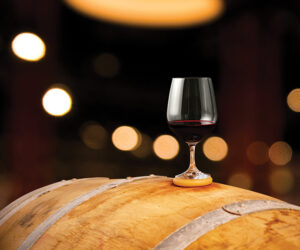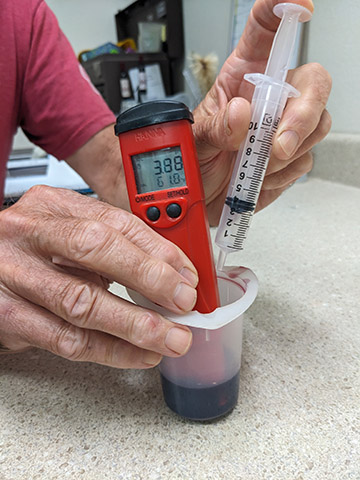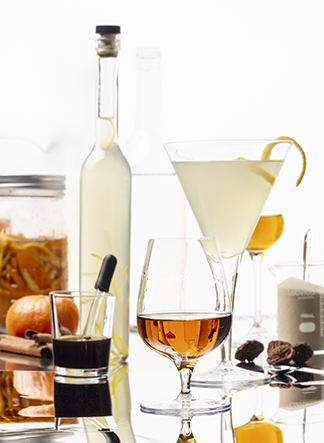
Liqueurs are both delicious and incredibly easy to make. And the final result is accomplished in a fraction of the time as a carefully aged batch of wine. Why spend top dollar for liqueurs from the store when you can make ones that taste as good, if not better, for a fraction of the cost?
Before we begin, know that making liqueurs is almost foolproof: It is incredibly difficult to make a catastrophic mistake. If you add too much of the flavoring compounds (fruits, nuts, vegetables, flowers, or essences) you simply add more spirit and/or sugar syrup to dilute the flavor and if you find that you have added too little of the flavors, you simply add more. If you make wine you almost certainly have all the equipment you need to make liqueurs.
There are two basic methods of making liqueurs. One takes time, most often 2–4 weeks while the flavor compounds are macerated in the alcohol of your choice. The second method takes only hours and uses a sous vide precision cooker. In my opinion, one is not better than the other, but my preference is for the sous vide simply for the convenience and the fact I have a sous vide cooker. But if you don’t want to invest in one the other method will return equally enjoyable liqueurs. I will offer detailed instructions for both methods for each of the recipes in this story. But first, what equipment is required for making liqueurs at home?
Equipment:
1-quart (1-L) measuring cup
Measuring spoons
Digital scale
Small straining bags
Pestle and mortar, or a coffee grinder
Saucepan
Fine-mesh strainer
Coffee filters
Wide-mouthed funnel
Sealable quart/liter glass jars
Bottles for storing your liqueurs
Labeling materials
My preference is to start with vodka as the base, but you may use any spirit you prefer or have at hand. These recipes assume that your alcohol is about 40% ABV (80 proof), which is typical for vodka, Scotch, rum, tequila, and gin. This assumption is important because if you take 500 mL of spirits at 40%, you can add about 170 mL of sugar syrup to produce a liqueur at 30% ABV. Or 300 mL of syrup to make a 25% ABV liqueur. For other starting volumes, ABVs, or different finishing ABVs, you will need to use an online alcohol calculator or the Pearson Square (read more about how to do that here: www.winemakermag.com/article/the-pearson-square).
You may want to consider filtering your liqueurs. Lining the mesh strainer with a coffee filter works well, but the process is as slow as watching paint dry. Moreover, if you are filtering a recipe with something like elderflowers, you may find that you will need to change the filters more than once as they become clogged. However, filtering is not required for most recipes.
One last point before we get to the recipes: Everyone’s taste is unique and you can make these liqueurs more or less sweet to suit your palate by adding more or less sugar. I prefer to drink these liqueurs as stand-alone aperitifs or digestifs and don’t use them to make cocktails, but there are countless cocktail recipes online to which you could use a splash or two of these creations, and all can transform a scoop of ice cream or a cup of coffee or tea in delightful ways. They also make special birthday, holiday, and “thank you” gifts for those we hold dear.
Now let’s get to the recipes, in which I’ll cover techniques for making each liqueur.
Amaretto
This is a very simple recipe. Amaretto is an Italian liqueur that tastes of almonds, but it is often made from apricot pits or peach pits, whose seeds have a strong almond flavor.
Ingredients
500 mL vodka
1 Tbsp. almond extract
1 tsp. vanilla extract
3 sticks cinnamon
½ cup sugar
½ cup water
Step by step
In a jar with 500 mL of vodka, pour the almond and vanilla extracts. Bring ½ cup of water to a boil and whisk in the sugar until it is completely dissolved and the syrup is clear. When clear, add 3 cinnamon sticks. Continue to boil for 10 minutes to extract the heat and flavor from the cinnamon. Turn the heat off and allow to cool overnight.
Strain out the cinnamon and then add the syrup to the liquor and shake to blend.
Bottle, label and enjoy.
Chocolate Liqueur
This liqueur is liquid chocolate for adults. It may make for a fun ingredient to fortify the right wine with to make a dessert wine.
Ingredients
500 mL of vodka
1 cup crushed and roasted cocoa nibs
1 tsp. vanilla extract (or ½ vanilla bean, sliced from top to
bottom with paste scraped)
½ cup sugar syrup (made from 2 parts sugar, 1 part water)
Sous vide method
Pour 500 mL of 80-proof vodka into a sealable jar. For safety reasons, use a jar that is large enough to provide you with about 1–2 inches (2.5–5 cm) of headspace when ready for immersion.
I buy crushed cocoa nibs. You will extract more flavor if they are crushed, which if you buy whole nibs you can do in a coffee grinder or a food processor. You want only to break the nibs, so grind by pulsing for a few seconds.
Roast 1 cup of nibs on a tray in an oven set at 350 °F (177 °C) for 10 minutes and allow to cool. Your kitchen should be filled with the aroma of chocolate.
Pour the nibs into the jar with the vodka. Carefully scrape the seeds and paste of the vanilla bean into the jar and add the bean.
Set the sous vide precision cooker to 150 °F (66 °C) for two hours and immerse the jar when the water bath hits this temperature.
While the liquor is cooking, make the simple syrup by dissolving 2 cups of sugar in 1 cup of boiling water. The syrup should be very clear when all the sugar has dissolved. Allow the syrup to cool to room temperature.
Remove the jar after two hours and allow to cool to room temperature. Strain the contents through a fine mesh strainer to remove the vanilla bean and nibs.
Measure the volume of the liquor. If there has not been a significant loss of liquid, add about 250 mL of the syrup to the jar for a total of 750 mL. If nibs have absorbed a significant amount of liquor, add syrup (or dilute the syrup with water) for a total volume of 750 mL.
Fill your bottles, label, and enjoy.
Tincture method
Ignore all references to the sous vide. Instead, macerate the cocoa nibs and vanilla in the vodka for 2–3 weeks, in a cabinet at room temperature. Be sure to agitate the jar daily. Strain, bottle, label, and enjoy.
Limoncello
Limoncello is a traditional Italian digestif. Because this recipe uses the zest of lemons and because lemons are subject to all kinds of pesticides, it is best to use organic lemons (or lemons that you know have not been sprayed). Wash and scrub the lemons to help remove any chemical residue on the peels.
Ingredients
500 mL vodka
5 lemons (1 lemon for every 100 mL of spirit)
½ cup of sugar
½ cup water
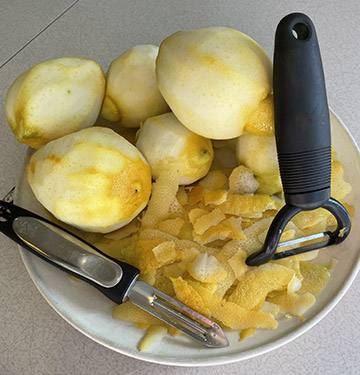
Sous vide method
Zest the lemons with a vegetable peeler so that you have only the yellow peel and as little as possible of the white pith. The peeler will leave you with long strips of zest and the strips will tend to make filtering less challenging than if you had grated the lemons with a zester.
Add the zest to a jar and pour 500 mL of vodka over it. For safety reasons, use a jar that is large enough to provide you with about 1–2 inches (2.5–5 cm) of headspace when ready for immersion. Close the lid tightly and heat the water bath to 150 °F (66 °C) with your sous vide. Place the jar with the vodka and zested peel in the bath and cook for two hours. Afterwards, allow the jar to sit in the hot water as it cools.
Make a sugar syrup by boiling ½ cup of sugar in ½ cup of water.
The next day, strain the liquor to remove the zest.
Measure the volume of liquor you have to determine the appropriate amount of syrup you should add to the liquor to make a liqueur at 30% ABV. If no significant volume of liquid was absorbed by the zest then the amount of syrup to add is 170 mL.
Bottle and label this liqueur and store in your freezer. This can be enjoyed at room temperature but it tastes so much better when sipped very cold from the freezer.
Tincture method
Ignore the line about the use of a sous vide and instead macerate the zest and vodka for 2–3 weeks on a shelf in a cupboard, remembering to shake the jar at least daily. Follow the same instructions for sweetening.
Génépy
This is not a clone for the traditional French herbal liqueur that’s been around for centuries. For this recipe I use a strain of artemisia used to make absinthe (artemisia absinthium). You can find this at your local homebrew store. Génépy is usually made from artemisia genepi or artemisia umbelliformis.
Ingredients
500 mL vodka
½ oz. (14 g) dried wormwood leaves and stems
1 cup sugar (in classic génépy recipes, 40 cubes of sugar are added to 1 L of 40% ABV spirits)
Sous vide method
Place ½ oz. (14 g) of dried wormwood leaves and stems in 500 mL of vodka and close the lid tightly. For safety reasons, use a jar that is large enough to provide you with about 1–2 inches (2.5–5 cm) of headspace when ready for immersion.
Heat water bath to 150 °F (66 °C) in the sous vide and place jar in bath for two hours. Allow to cool and strain using a fine-mesh sieve.
Add 1 cup of sugar to the génépy and shake until dissolved. Bottle, label, and enjoy.
Tincture method
Add ½ oz. (14 g) of dried wormwood to 500 mL of vodka in a jar and tightly close the lid.
Allow to macerate for 40 days, the traditional length of time to extract the flavors and colors from the herb, agitating the jar daily.
Follow instructions in the first method from the time the macerated wormwood has cooled.
Chocolate Orange liqueur
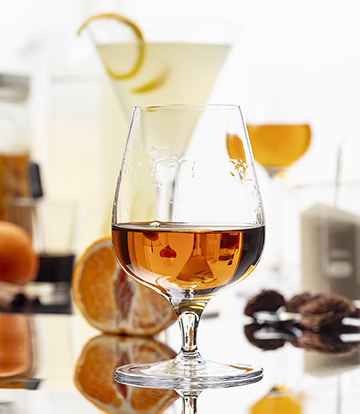
Chocolate orange is a very popular candy. It also makes a delightful digestif. This liqueur is my variation on the Israeli Sabra liqueur.
Ingredients
500 mL vodka
zest of 5 oranges
4 oz. (113 g) cocoa nibs
1 tsp. vanilla extract (or ½ vanilla bean, sliced from top to bottom with paste scraped)
½ cup of sugar
½ cup water
Sous vide method
Place 4 oz. (113 g) of crushed or broken cocoa nibs on a tray and roast them at 350 °F (177 °C) for 10 minutes. Allow to cool.
Wash and scrub the oranges and carefully zest them in strips, avoiding the white pith.
Add the cocoa nibs, orange zest, and ½ vanilla bean (or tsp. of vanilla extract) to a small straining bag and put the bag into a jar. Cover with 500 mL of vodka. For safety reasons, use a jar that is large enough to provide you with about 1–2 inches (2.5–5 cm) of headspace when ready for immersion. Close the jar tightly and heat a water bath to 150 °F (66 °C) with the sous vide. Place the jar in the basin and set the sous vide unit for two hours. After two hours, allow the contents to cool with the water.
When cooled, remove the bag, allowing it to drip dry into the jar. Do not squeeze the bag, as it will make filtering the liqueur more difficult.
Boil ½ cup of sugar in ½ cup of water and stir until the sugar is fully dissolved and the syrup is clear. Measure the volume of liquor and determine how much syrup to add to create a liqueur at 30% ABV. If no significant loss of liquid is found, then the total volume should be about 170 mL. If a significant amount of liquid is lost to the nibs and orange zest, then reduce the amount of syrup accordingly (use an online alcohol calculator or the Pearson Square).
Bottle, label, and enjoy.
Tincture method
Ignore the line dealing with the water bath and sous vide, and macerate the orange zest, nibs, and vanilla in a cupboard at room temperature for three weeks, giving it a shake every day. Then follow method 1 from the point where you strain the contents of the straining bag.
Horseradish Bitters
This is not really a liqueur as it has no added sweetness, but if you are looking for something bracing that does not include chili peppers, you might try this. Be very aware that the alcohol will extract the heat from the horseradish in hours, not weeks.
Ingredients
500 mL of vodka
2-inch (5-cm) fresh horseradish root
Step by step
Peel the horseradish and slice into 5 or 6 roundels. Place the roundels in a jar and pour in 500 mL of vodka. Close the lid tightly and shake vigorously for a few seconds. Place the jar in a dark cupboard at room temperature.
Taste after 12 hours. If the flavor is not as intense as you like, wait another 12 hours and check again. When the flavor is to your satisfaction, strain the vodka to remove the horseradish and bottle, label, and enjoy. While you can drink this at room temperature, like limoncello, it is best served from the freezer.


